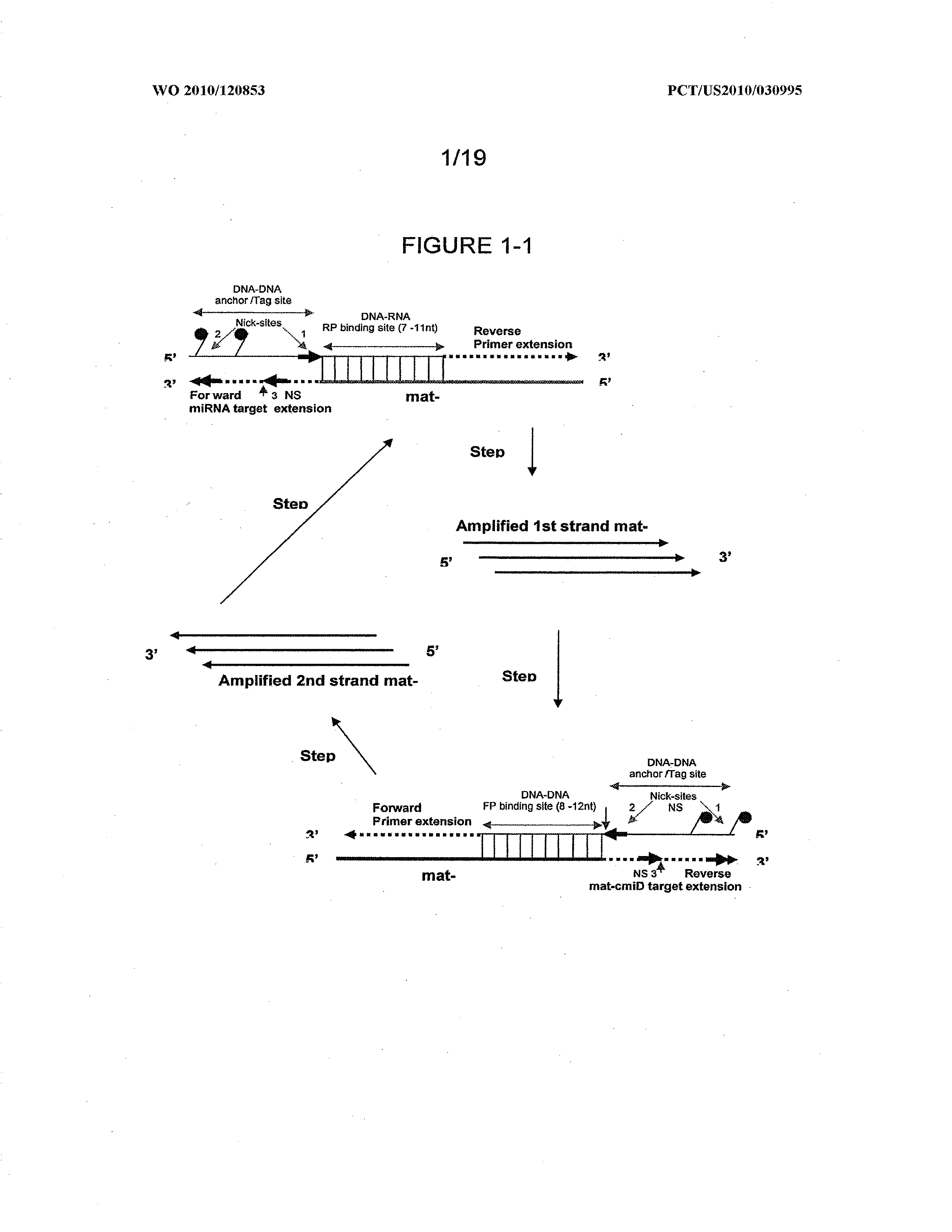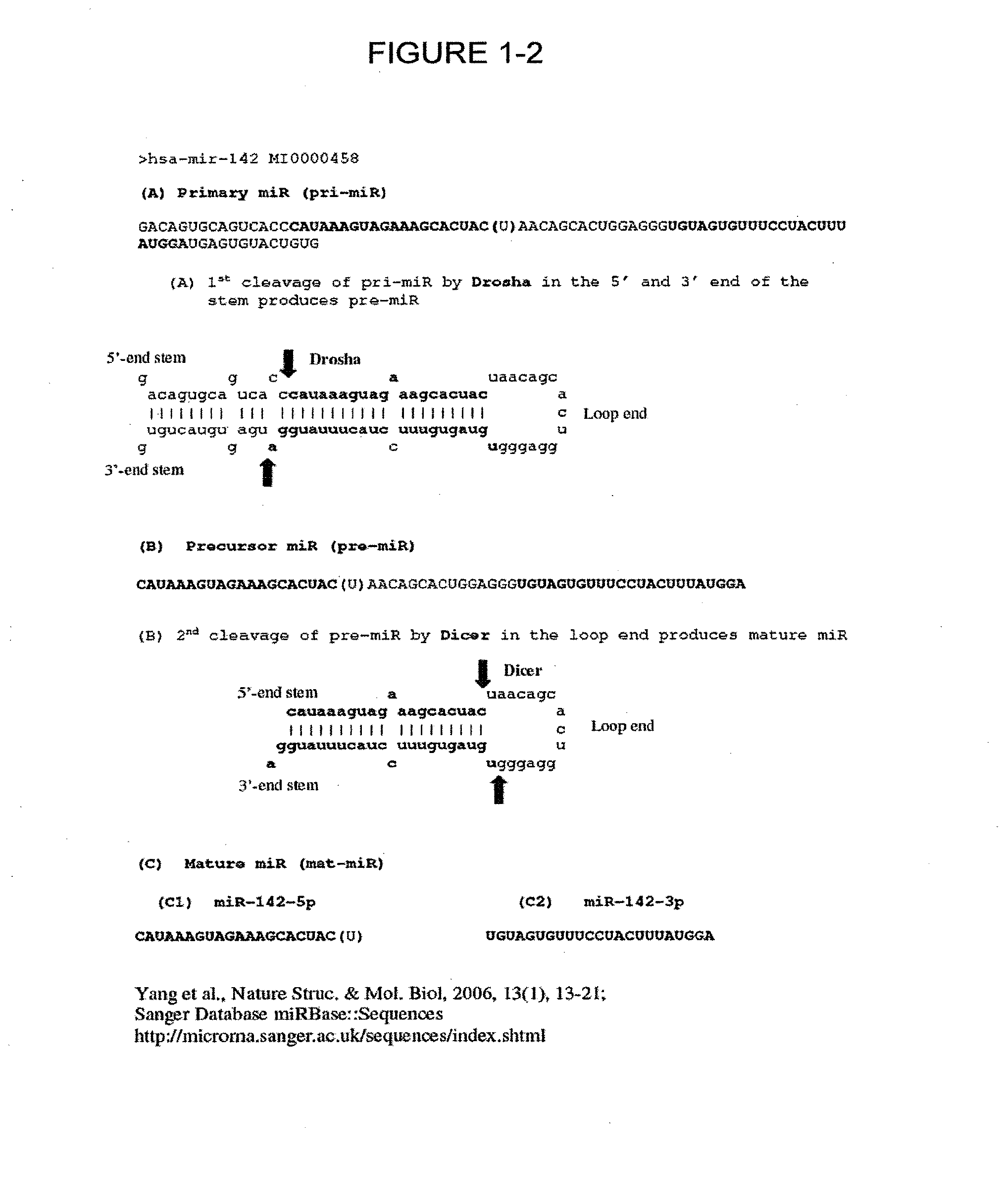Methods and compositions to detect and differentiate small rnas in RNA maturation pathway
- Summary
- Abstract
- Description
- Claims
- Application Information
AI Technical Summary
Benefits of technology
Problems solved by technology
Method used
Image
Examples
example 1
miRFRNDA Method for Detection of mat-miR Versus Pre-miR
[0112]The detection of small RNAs in the following examples 1 to 3 of the invention employed the miRFRNDA assay linear non-cyclic amplification scheme shown in FIG. 2, using stem-loop reverse and forward primers as depicted in FIG. 3A (SEQ ID NO: 1) and FIG. 3B (SEQ ID NO: 2), respectively and synthetic miR-24-2-3p template (FIG. 4A) (SEQ ID NO: 6) and cmiD-24-2-3p template (SEQ ID NO: 10) unless otherwise stated. The components and reagent concentration in each 1× reaction are given in Table 1A and 1B, respectively.
TABLE 1ASingle step miRFRNDA assay components25 ul / rxnReaction componentsstock concVol ulNEB 3 buffer10x3NEB 2 buffer10x0.5thermopol buffer10x5taq buffer10x4BSA10ug / ul0.4dNTPs10x (10 mM)2.5Nt.BstNB110U / ul1rBst50U / ul1mat-miR template2.5uM0.5mat-cmiD template2.5uM0.5RP_lp*50uM0.5FP_lp*50uM0.5nuclease free water4.6
TABLE 1BSingle step miRFRNDA Assay using labeled lp_PPfinal conc [mM]Reagents1x rxnTris-HCl42.20NaCl67.00KC...
example 2
miRNA Detection by Monitoring Independently Reverse And Forward Reaction
[0114]The examples of the disclosed method shown in FIG. 5 and FIG. 6 were carried out for 25 minutes under conditions described in Example 1 and specified in Table 1A and 1B. The templates were used at 50 nM concentration. In the experiment the Step 1 reaction (FIG. 5) was carried out with mat-miR-24-2-3p (SEQ ID NO: 6), a RNA template; and the step 2 reaction (FIG. 6) was carried out with mat-cmiD-24-2-3p (SEQ ID NO: 10), the cDNA template. The Step 1 reverse transcription reaction followed by nicking and strand displacement in the reverse direction was monitored by release of CalFO 560 (F2) reporter fluorescence. The step 1 forward reaction using the miR-24-2-3p template itself as the forward primer was monitored by release of FAM (F1) reporter fluorescence by strand displacement. The Step 2 forward reaction was monitored by release of Quasar 670 (F3) reporter fluorescence by strand displacement.
[0115]The rel...
example 3
Use of miRNA as Forward Primer for Extension and Specificity of mat-miR Detection
[0119]In this example (FIG. 7A) mat-miR-24-2-3p (SEQ ID NO: 6) was used as the template at concentrations ranging from 5E+02 nM (1.25 pmol) to 5E-05 nM (0.125 amol). Detection of low template concentrations (at higher primer concentrations) was enabled by low NTC background when ratio of RP_lp*** to mat-miR-24-2-3p template was optimized and maintained at least 5:1 ratio for all template concentrations. Under these conditions FP_lp** could be held constant at 1 uM without any increase in NTC background. The plots in FIG. 7A represent RFU values at each template concentration with the respective values of NTC deducted. Other reaction components and conditions were same as shown in Table 1 and Table 2.
[0120]This study demonstrates that miRNA template itself can be used as a forward primer for extension of templates at the 3′ end by polymerases such as the rBst (FIG. 7B). This feature in step 1 reaction of...
PUM
| Property | Measurement | Unit |
|---|---|---|
| Time | aaaaa | aaaaa |
| Time | aaaaa | aaaaa |
| Digital information | aaaaa | aaaaa |
Abstract
Description
Claims
Application Information
 Login to View More
Login to View More - R&D
- Intellectual Property
- Life Sciences
- Materials
- Tech Scout
- Unparalleled Data Quality
- Higher Quality Content
- 60% Fewer Hallucinations
Browse by: Latest US Patents, China's latest patents, Technical Efficacy Thesaurus, Application Domain, Technology Topic, Popular Technical Reports.
© 2025 PatSnap. All rights reserved.Legal|Privacy policy|Modern Slavery Act Transparency Statement|Sitemap|About US| Contact US: help@patsnap.com



